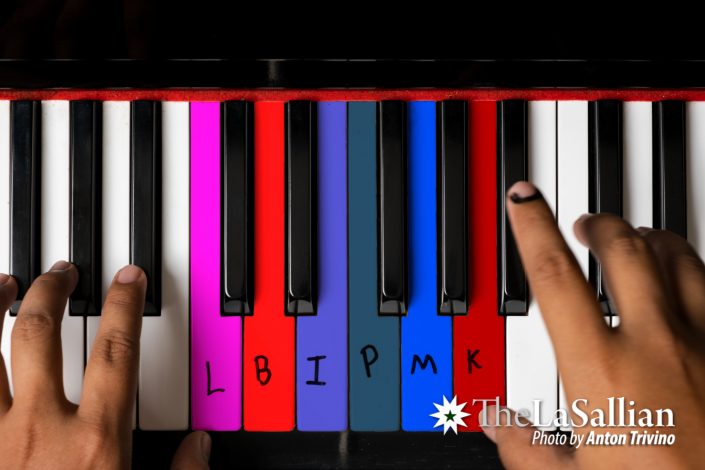As election season draws closer, bustling caravans carrying election paraphernalia march on the streets. Familiar faces are plastered all over social media, and campaign jingles can be heard from a mile away. After all, a charming and well-known politician with catchy music will surely leave an impression among the voting population, which might just secure their win.
For political hopefuls, campaign jingles—with their repetitive allure and conversational nature—are a worthy tool to make themselves memorable. A melodramatic trite to some and a strategic political art to others, campaign jingles speak volumes about the electoral dynamics in the country.

Skin deep
To Paul Francisco, an instructor at the Department of Political Science of the University of Santo Tomas, historical changes to electoral politics are key to understanding the rise of campaign jingles. With the 1973 Constitution lowering voter qualifications and enfranchising large swaths of the citizenry, candidates had to adjust to shifting grounds–and thus crafted creative approaches to appeal to the masses.
“Political campaigns changed drastically,” Francisco reasons, explaining that candidacies moved from being formal to becoming more personal—more relatable. “The masses [are] not really interested in listening to formal speeches or interviews,” he claims. “They are more interested [in] something that they can [resonate with].”
The growing commonness of campaign jingles heeds the past methods of former President Ramon Magsaysay, who popularized national-level campaign music in the 1950s. Francisco elucidates that Magsaysay’s populist tendencies underpinned his communication strategies to the public—which is why he sought to present his platforms to his constituents using simple, casual language.
“[Campaign jingles] are about trying to simplify things,” Francisco adds, explaining that platforms have to be presented creatively and in a short amount of time. “[It becomes] clear to the people na this is who you are, this is what you want to do, [and] this is what you’re going to do for them.” This is where campaign jingle composers come in. “You have to translate [the candidate’s advocacies or bills into digestible and catchy tunes] for people to understand [what they can offer],” muses Merlee Jayme, songwriter of Manny Villar’s 2010 campaign jingle, Naging Mahirap.
Campaign jingles sacrifice much of a candidate’s particulars—yet they are one of the only viable workarounds against the nature of the electoral public in the Philippines. “[The] majority of the voters do not really care about the details of [a candidate’s] work,” Francisco laments. “[So] a campaign strategist has to recognize that.”
After all, in the composer’s perspective, campaign jingles essentially reduce politicians to marketing commodities. “It’s just like any other job brief that we work on in advertising,” Jayme mentions. “[It] is just that the product is a person.”
Music in politics
Campaign jingles are among the most effective ways of political marketing and advertising in the country, as it is rooted in Filipinos’ fondness for music, which Francisco and Jayme both emphasize.
With the Philippine electoral culture being more “personalistic rather than programmatic”, as Francisco discusses, political campaigns should be done in a way where it would resonate with the voters and tell them what they need to know about the candidates—which is what campaign jingles do.
“When it comes to jingles or music, for me, the main reasons why you use [them are] to elicit emotion and the other one is for entertainment and memorability,” Jayme furthers.
Francisco explains that even for the “old type of music” in the country, appealing to the listeners’ emotions through storytelling is considered an important element. This is also what campaign jingles have as one of its main objectives: to heighten the candidates’ probability of winning through music that entertains and captures the voters’ attention and emotions.
“The most important thing is, when it comes to the rhythm, when it comes to the melody of the music, it should be something catchy. It should be something that can be remembered,” Francisco furthers. “Sa [campaign] jingle, it’s a good way for people to remember a particular candidate.”
Jayme mentions that one way of doing so is by telling a story where voters can relate to a candidate. Just like with Manny Villar’s Naging Mahirap, it specifically targets the impoverished—which accounted for a quarter of the Philippine population in 2009—encouraging them to vote for a candidate with similar life experiences.
“Real stories are also very compelling for voters,” she asserts. But this is not the case for all.
In fulfilling the objective of making campaign jingles entertaining enough, there lie opportunities for these tunes to contain fabricated details or entire stories. Francisco adds that music is art; therefore, the components it has—such as literary devices—might also be used to tell “an exaggerated story or a blatant lie.”
To combat this, “It’s about trying to look at the lyrics, looking at the songs, and possibly determining whether it’s true or not,” he suggests.
But candidates must also be held accountable for the music they associate themselves with, which is part of their political campaign. Integrity should be taken into consideration when creating campaign jingles.
Moreover, Francisco emphasizes the role that entertainment politics plays in campaign jingles and political advertisements, “[Possibly,] we can relate the culture of Filipinos in elections wherein we love spectacle [and] we love entertainment. So minsan ‘yung mga people from showbiz, they can cross to politics because they are popular.” Hence, political advertisements have been getting more creative, from songs that will have people repeatedly singing them or having dance crazes that will trend on social media platforms.
“You have to convince the majority of the voters to identify themselves with you so that they will vote for you—that’s the main intention,” he adds.
With this, the combination of the celebrity factor in Philippine politics and the appeal to voters through storytelling is what makes campaign jingles effective as a campaign tool in the country. Through their tunes and lyrics, candidates’ political platforms are easily recalled by voters, even after election season.
